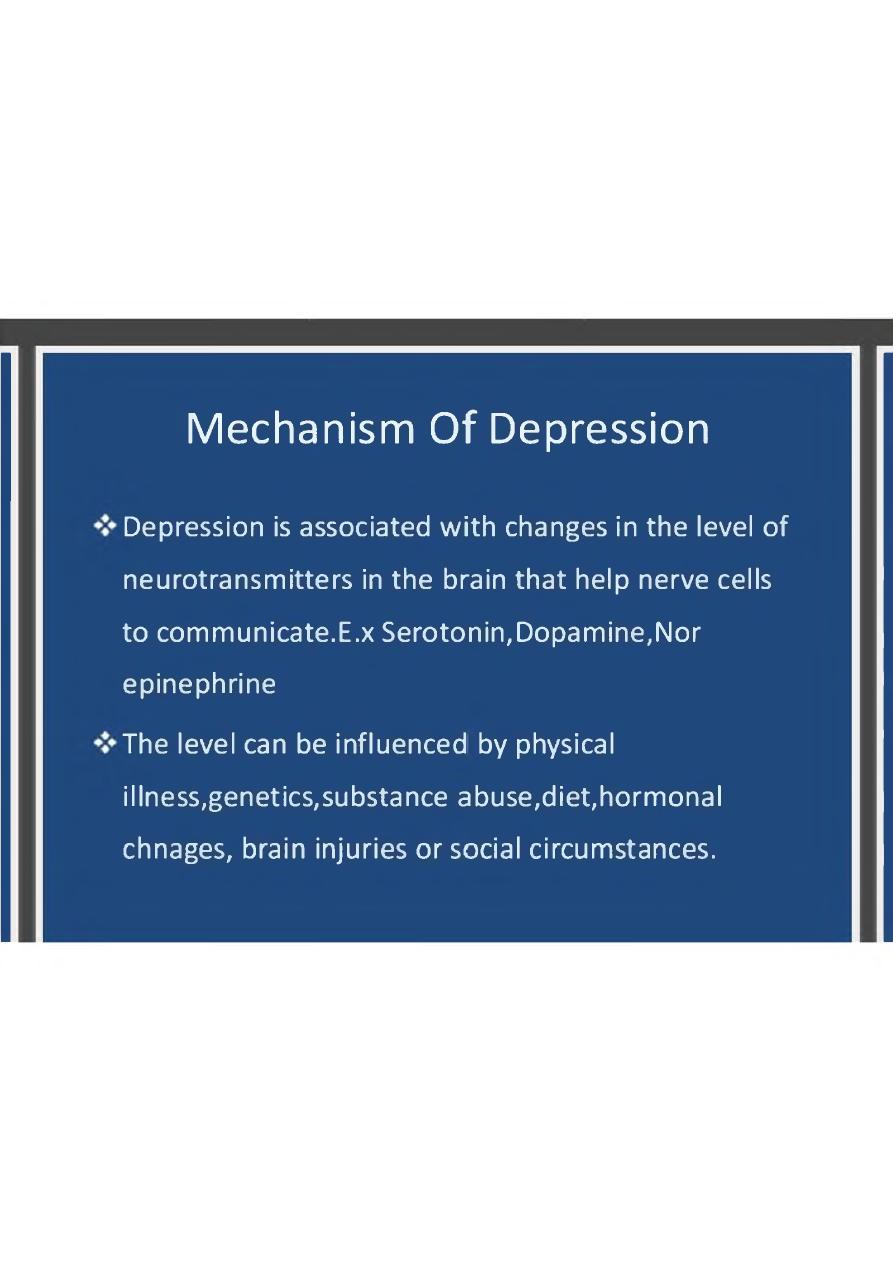
Mechanism Of Depression
Depression is associated with changes in the level of
neurotransmitters in the brain that help nerve cells
to communicate.E.x Serotonin,Dopamine,Nor
epinephrine
The level can be influenced by physical
illness,genetics,substance abuse,diet,hormonal
chnages, brain injuries or social circumstances.
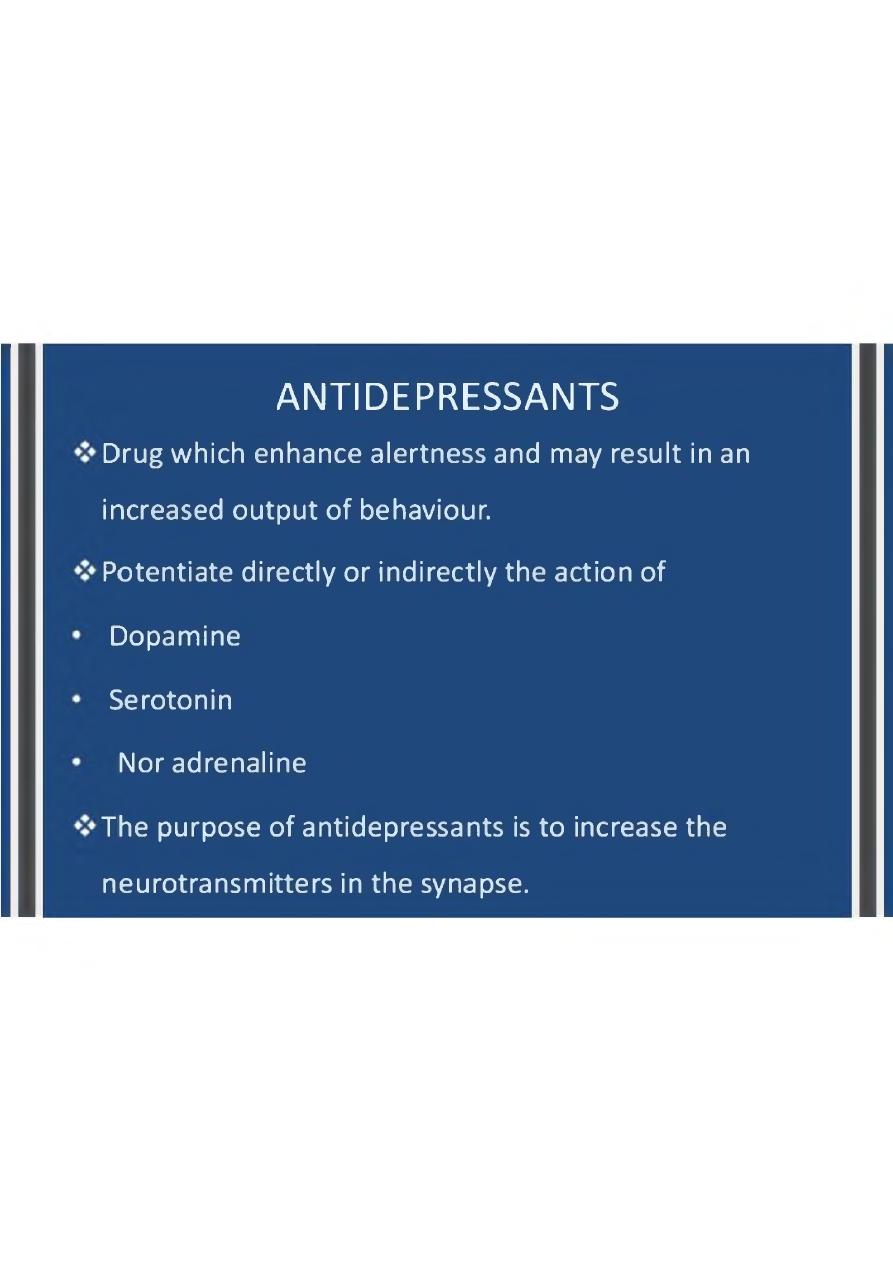
ANTIDEPRESSANTS
Drug which enhance alertness and may result in an
increased output of behaviour.
Potentiate directly or indirectly the action of
Dopamine
Serotonin
Nor adrenaline
The purpose of antidepressants is to increase the
neurotransmitters in the synapse.
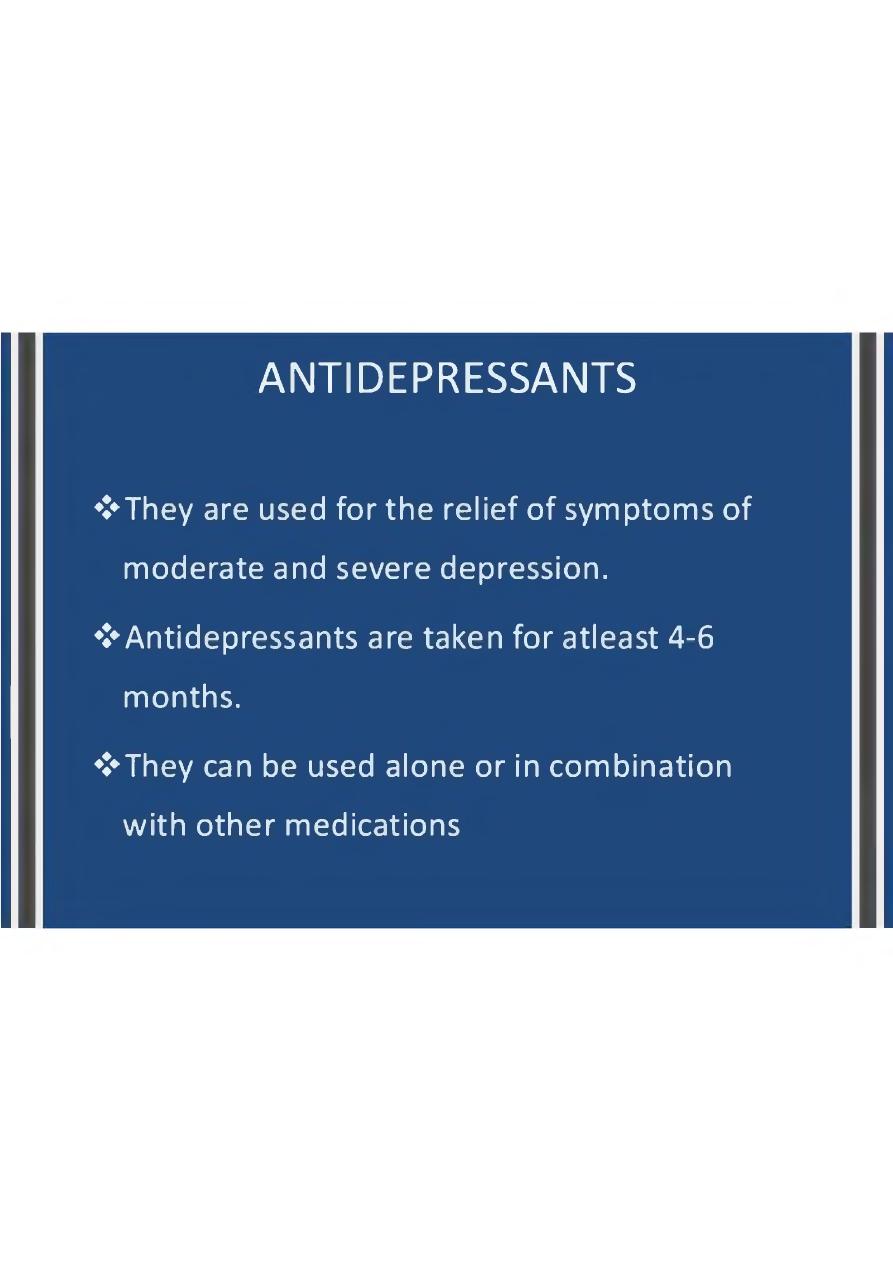
ANTIDEPRESSANTS
❖ They are used for the relief of symptoms of
moderate and severe depression.
❖ Antidepressants are taken for atleast 4-6
months.
❖ They can be used alone or in combination
with other medications
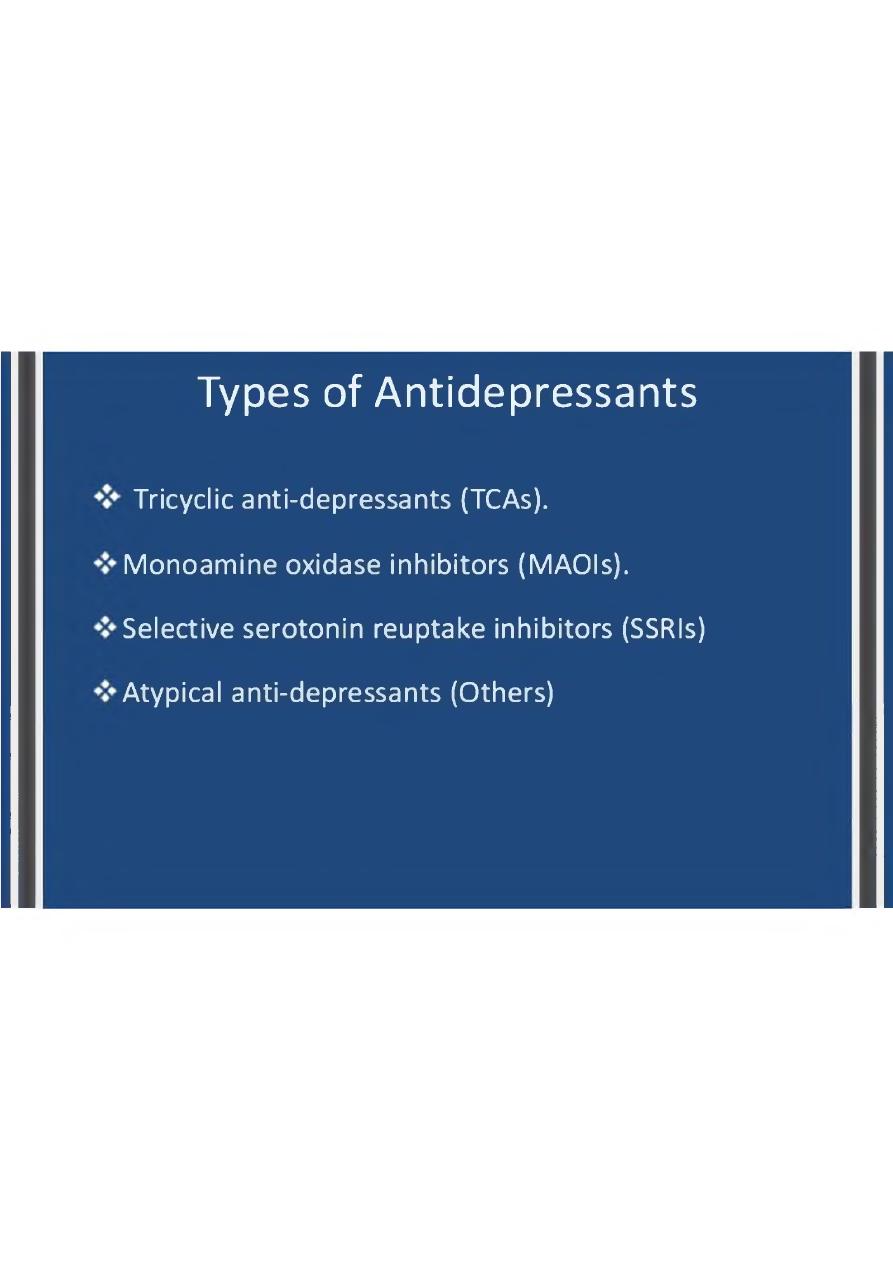
Types of Antidepressants
Tricyclic anti-depressants (TCAs).
Monoamine oxidase inhibitors (MAOIs).
Selective serotonin reuptake inhibitors (SSRIs)
Atypical anti-depressants (Others)
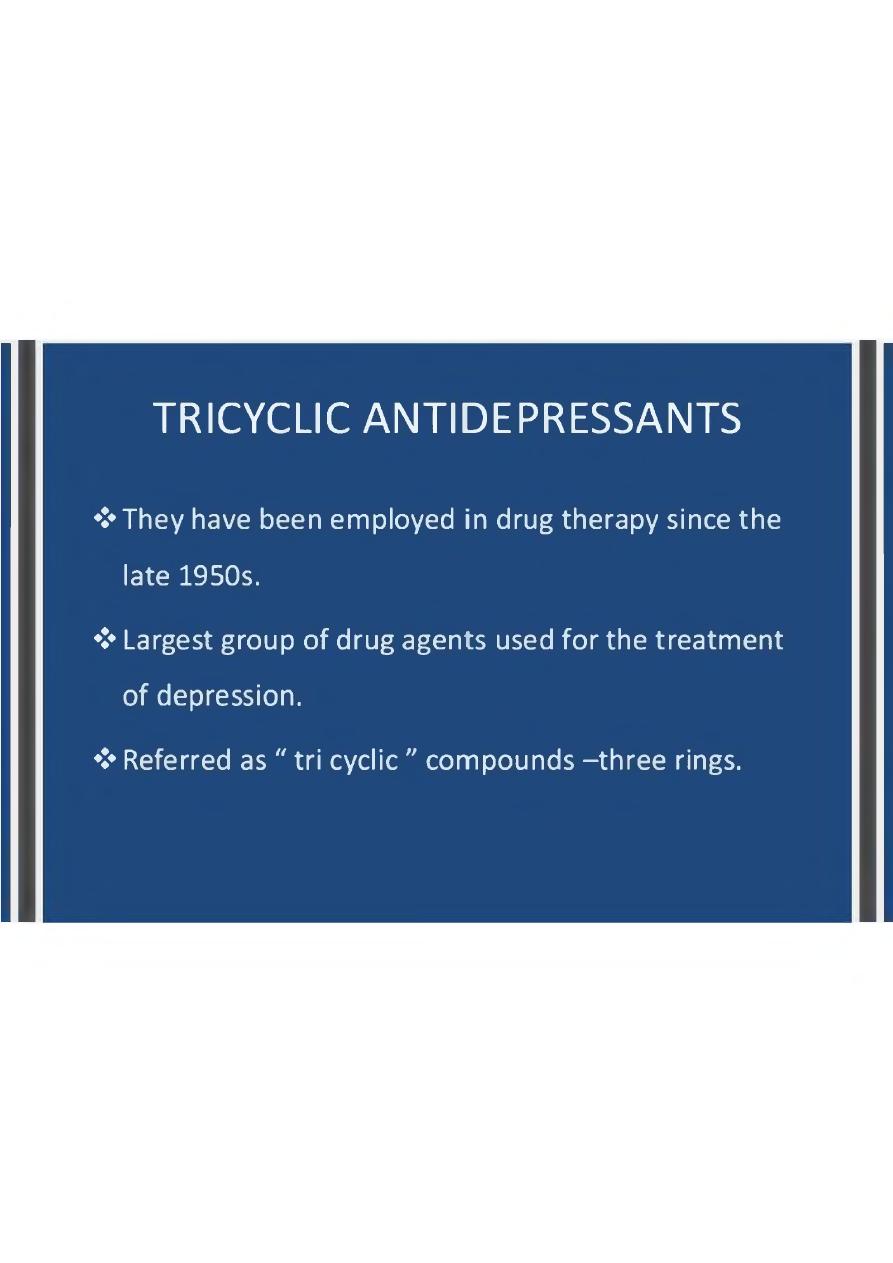
TRICYCLIC ANTIDEPRESSANTS
❖ They have been employed in drug therapy since the
late 1950s.
❖ Largest group of drug agents used for the treatment
of depression.
❖ Referred as " tri cyclic " compounds -three rings.
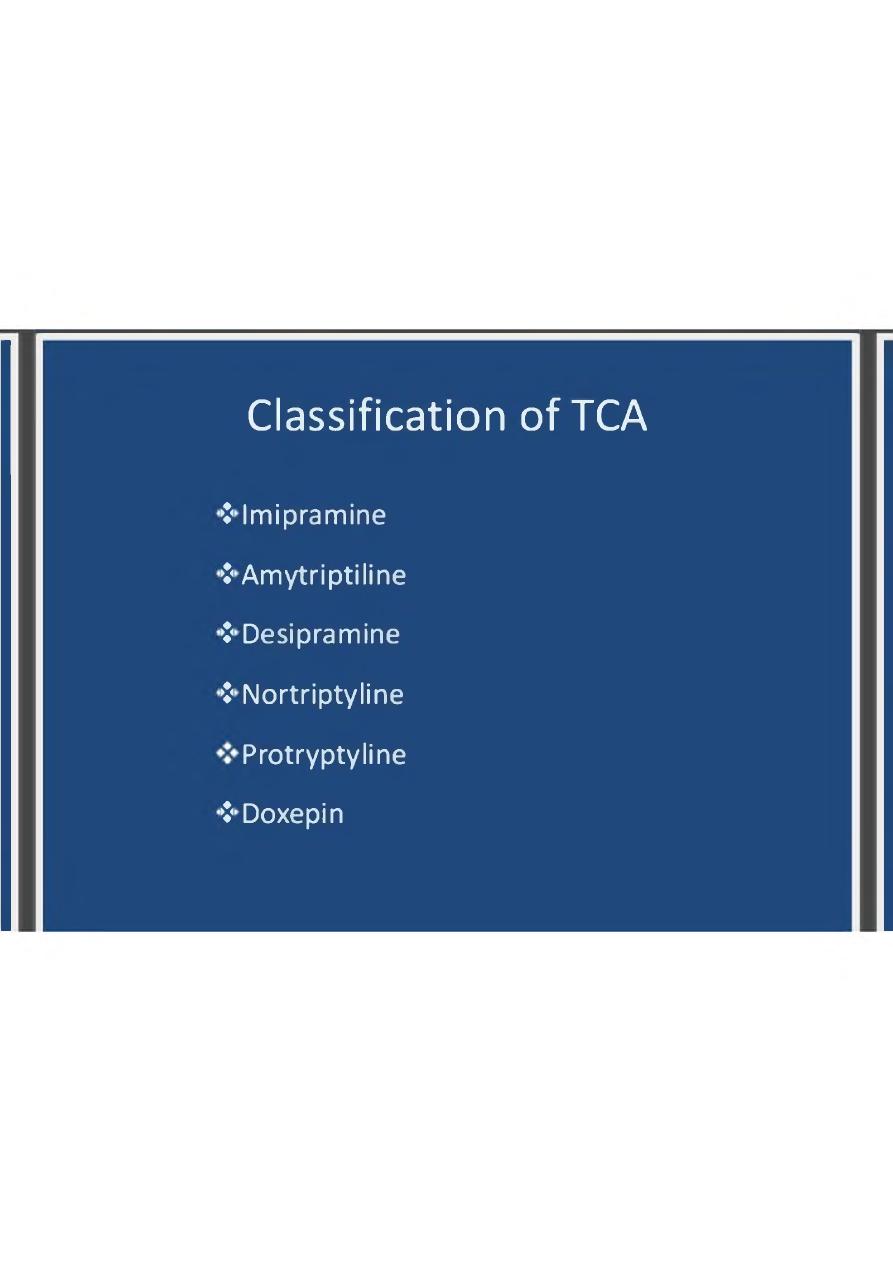
♦>
♦>
♦>
♦>
♦>
Classification of TCA
Imipramine
Amytriptiline
Desipramine
Nortriptyline
Protryptyline
Doxepin
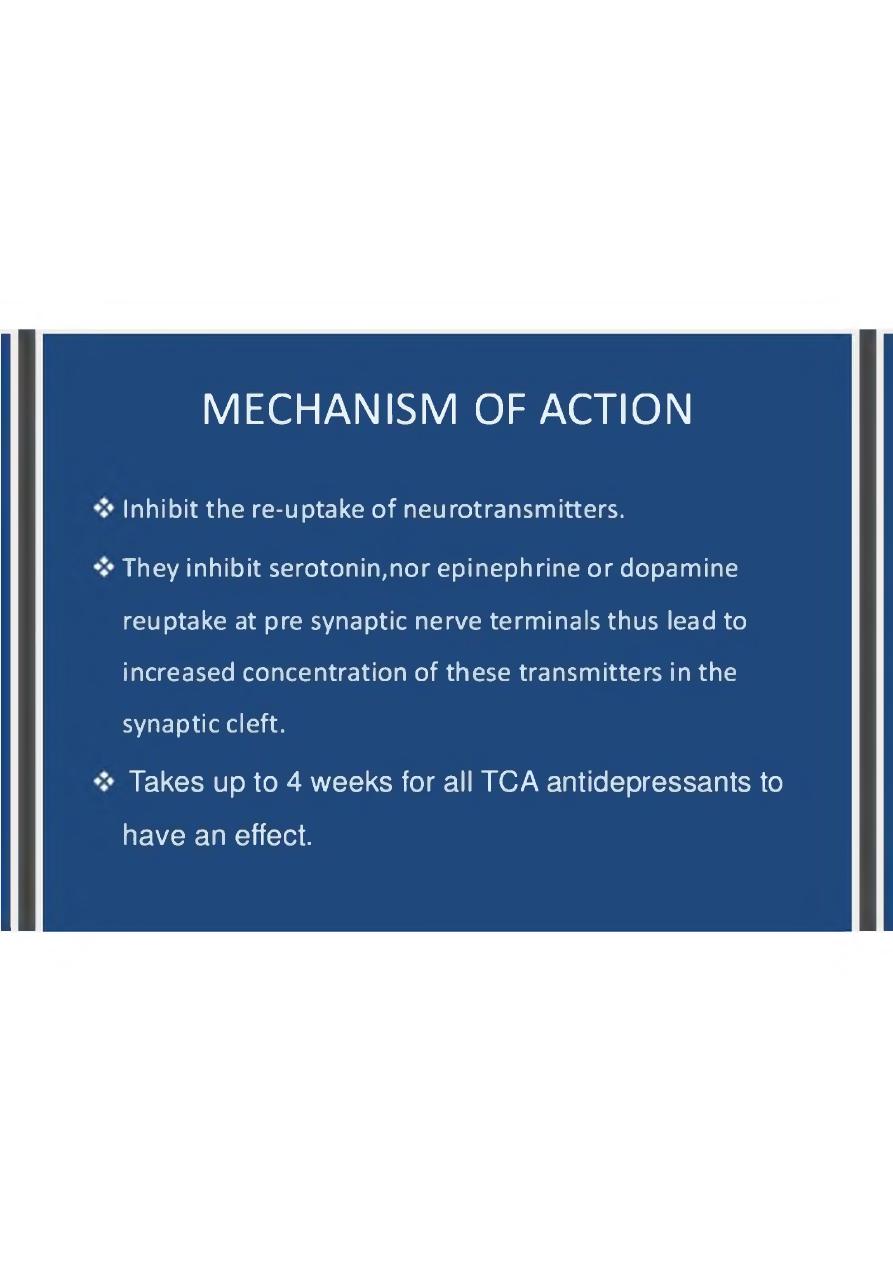
MECHANISM OF ACTION
Inhibit the re-uptake of neurotransmitters.
They inhibit serotonin,nor epinephrine or dopamine
reuptake at pre synaptic nerve terminals thus lead to
increased concentration of these transmitters in the
synaptic cleft.
Takes up to 4 weeks for all TCA antidepressants to
have an effect.
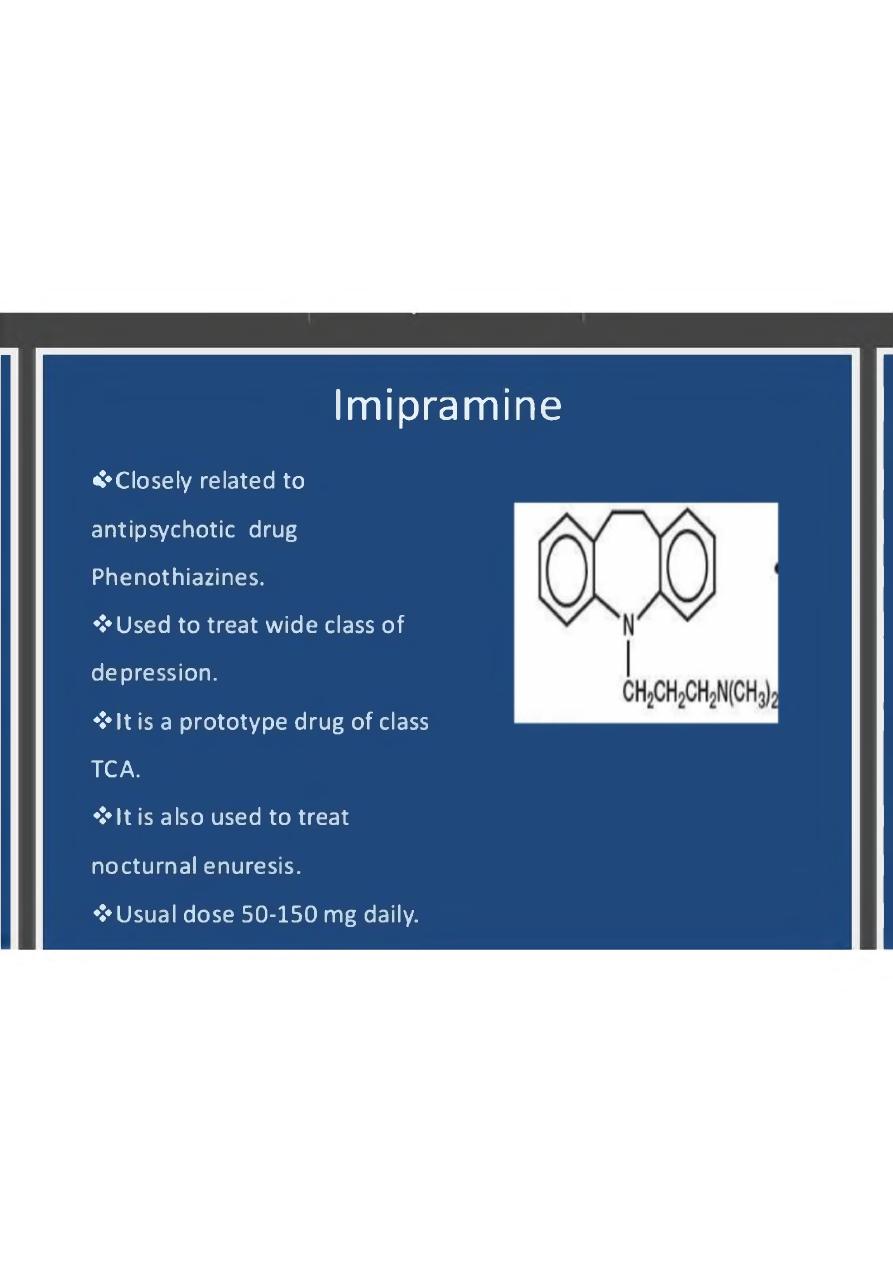
Imipramine
❖ Closely related to
antipsychotic drug
Phenothiazines.
❖ Used to treat wide class of
depression.
❖ it is a prototype drug of class
TCA.
❖ It is also used to treat
nocturnal enuresis.
❖ Usual dose 50-150 mg daily.
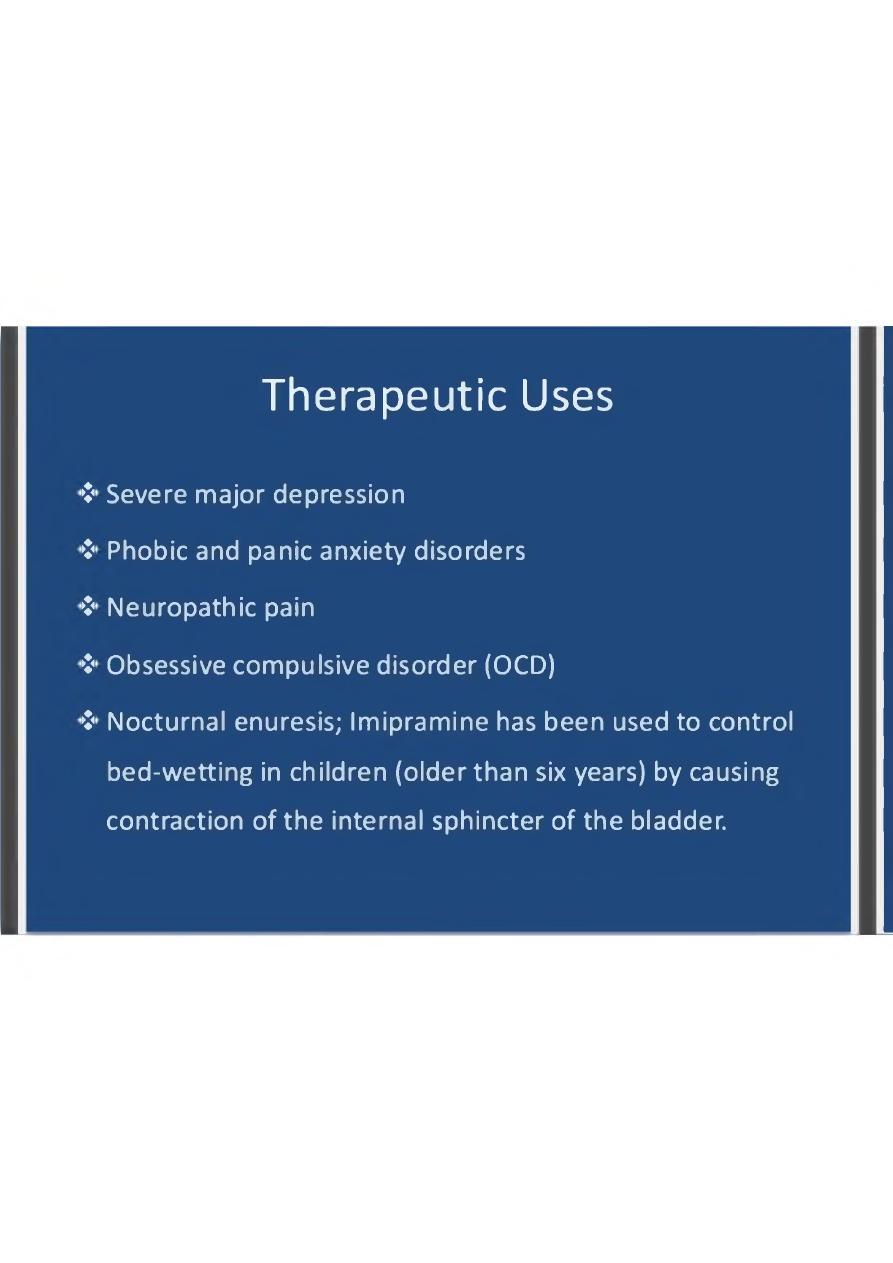
♦>
♦>
♦>
♦>
♦>
Therapeutic Uses
Severe major depression
Phobic and panic anxiety disorders
Neuropathic pain
Obsessive compulsive disorder (OCD)
Nocturnal enuresis; Imipramine has been used to control
bed-wetting in children (older than six years) by causing
contraction of the internal sphincter of the bladder.

Adverse Effects
❖ Dry mouth
❖ Urine retention
❖ Constipation
❖ Drowsiness
❖ Blurred vision
❖ Sedation
❖ Mydriasis
❖ weight gain
❖ Metallic taste
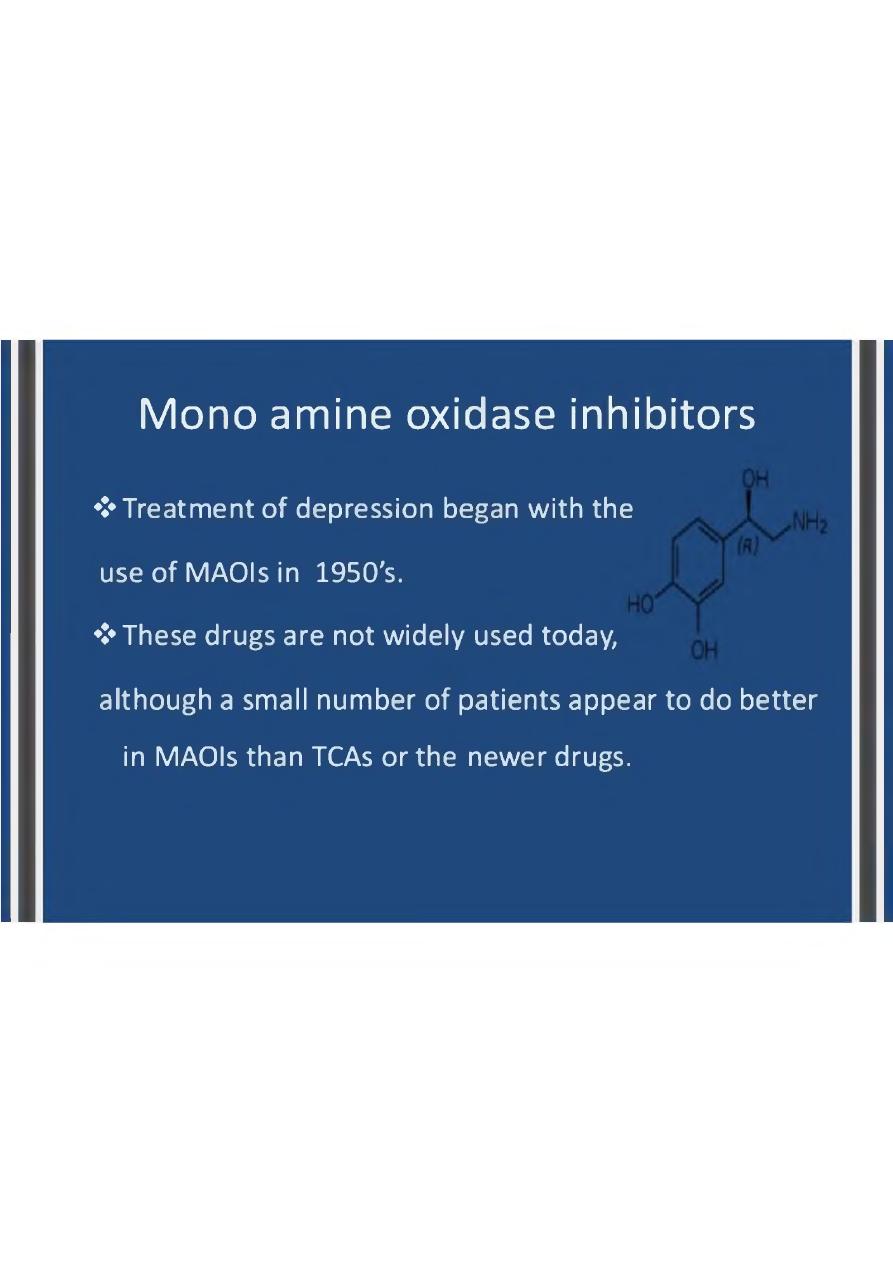
Mono amine oxidase inhibitors
❖ Treatment of depression began with the
useofM AOIsin 1950's.
❖ These drugs are not widely used today,
although a small number of patients appear to do better
in MAOIs than TCAs or the newer drugs.
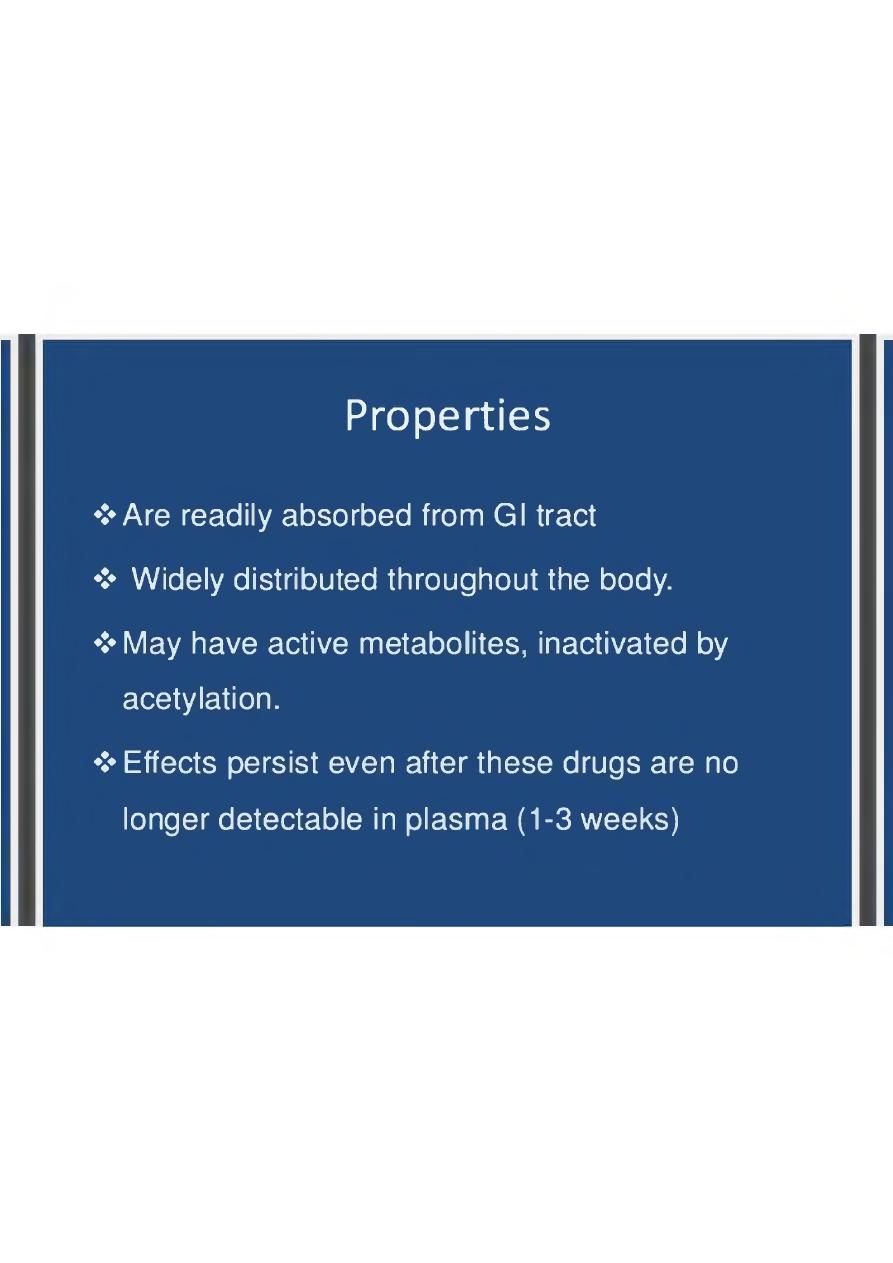
Properties
❖ Are readily absorbed from Gl tract
❖ Widely distributed throughout the body.
❖ May have active metabolites, inactivated by
acetylation.
❖ Effects persist even after these drugs are no
longer detectable in plasma (1-3 weeks)

Classification of MAOIs
❖ Phenelzine
❖ Isocarboxacid
❖ Tranylcypromine
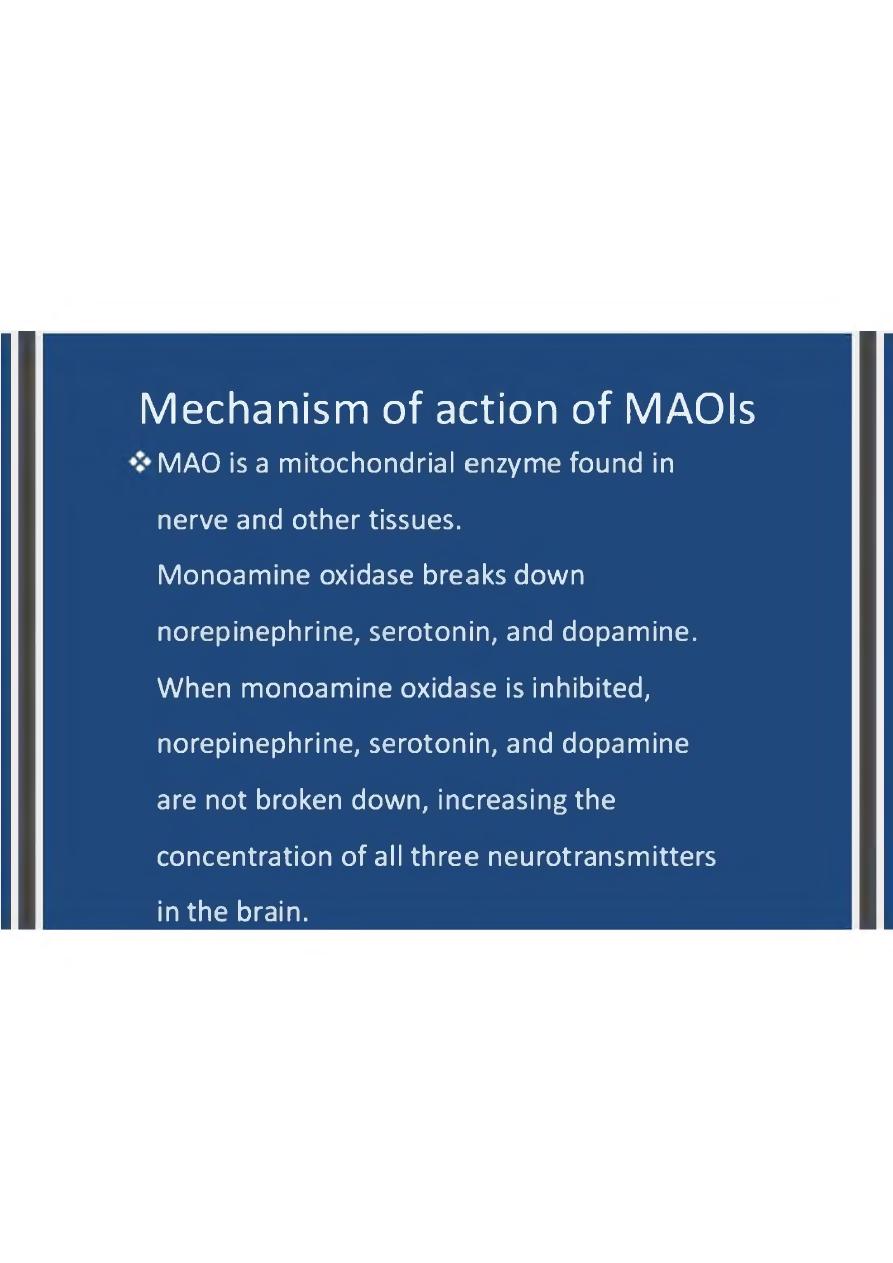
Mechanism of action of MAOIs
MAO is a mitochondrial enzyme found in
nerve and other tissues.
Monoamine oxidase breaks down
norepinephrine, serotonin, and dopamine.
When monoamine oxidase is inhibited,
norepinephrine, serotonin, and dopamine
are not broken down, increasing the
concentration of all three neurotransmitters
in the brain.
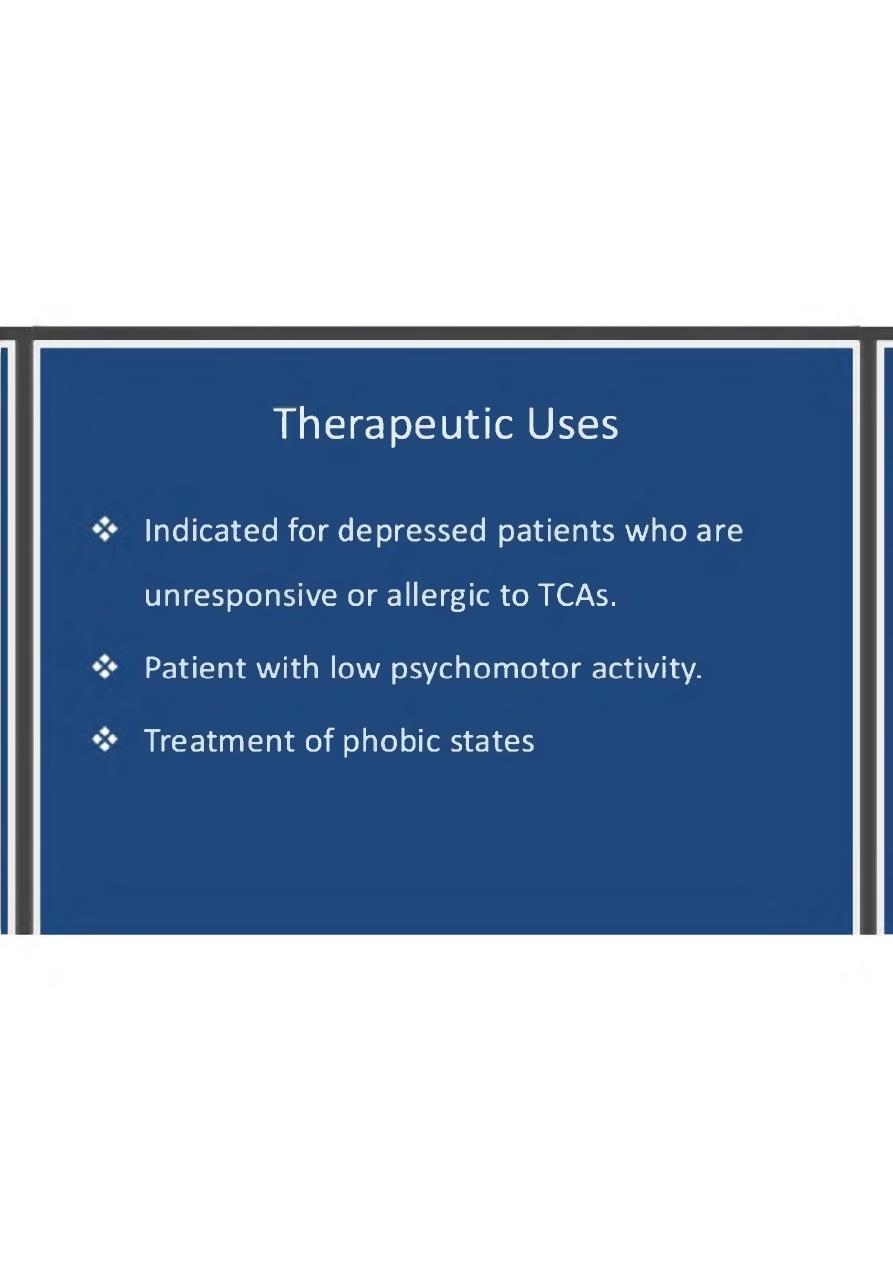
Therapeutic Uses
Indicated for depressed patients who are
unresponsive or allergic to TCAs.
Patient with low psychomotor activity.
Treatment of phobic states
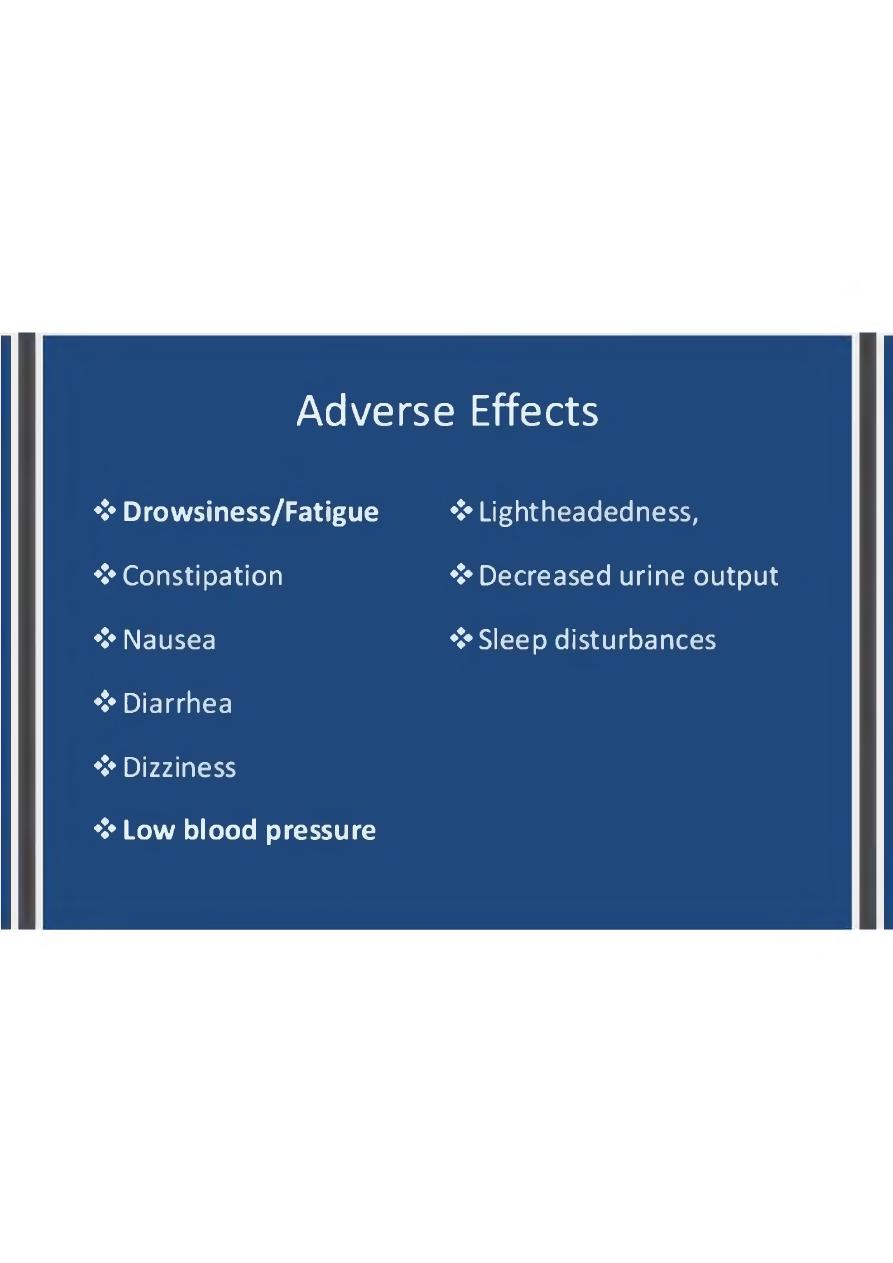
Adverse Effects
❖ Drowsiness/Fatigue
♦ > Lightheadedness,
❖ Constipation
❖ Decreased urine output
❖ Nausea
❖ Sleep disturbances
❖ Diarrhea
❖ Dizziness
❖ Low blood pressure
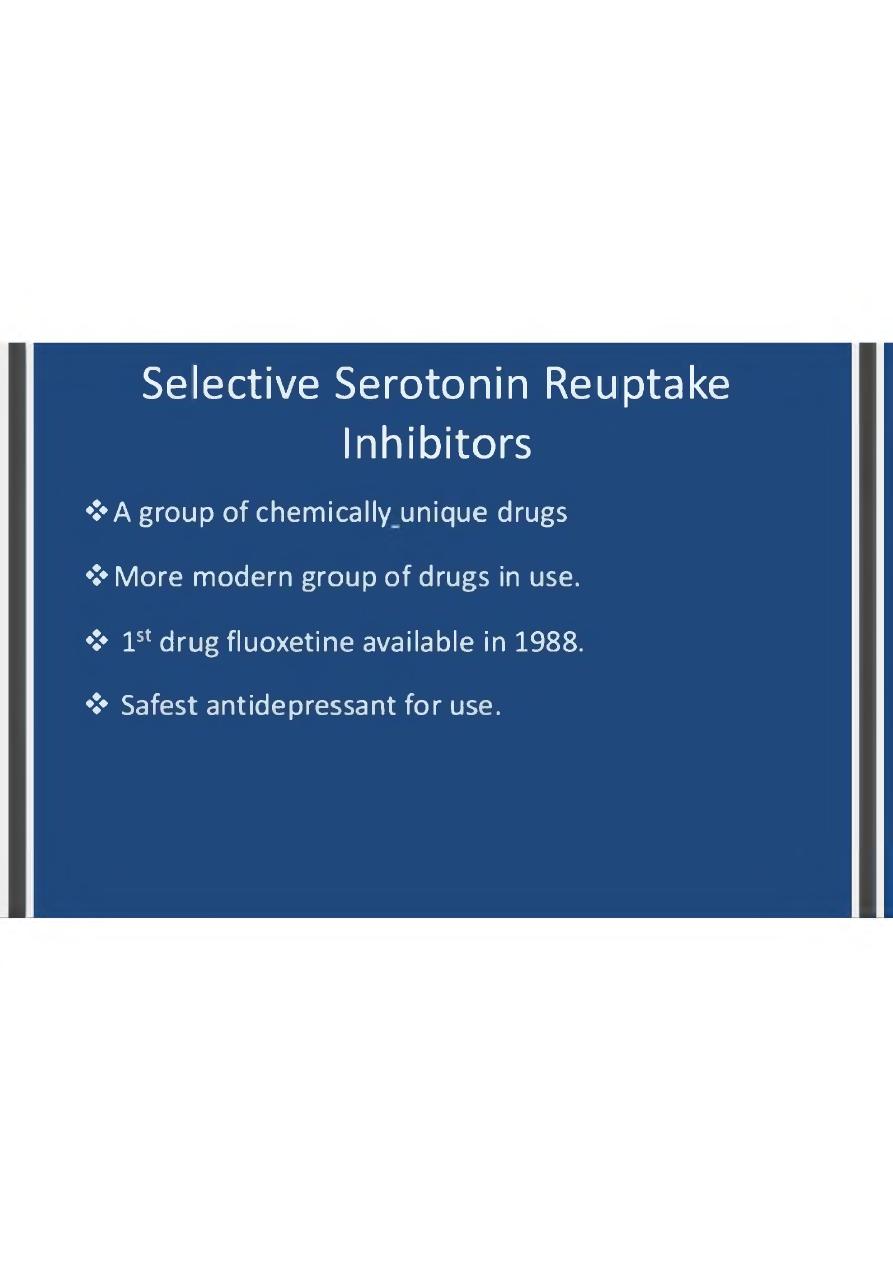
Selective Serotonin Reuptake
Inhibitors
❖ A group of chemically unique drugs
❖ More modern group of drugs in use.
❖ 1st drug fluoxetine available in 1988.
❖ Safest antidepressant for use.
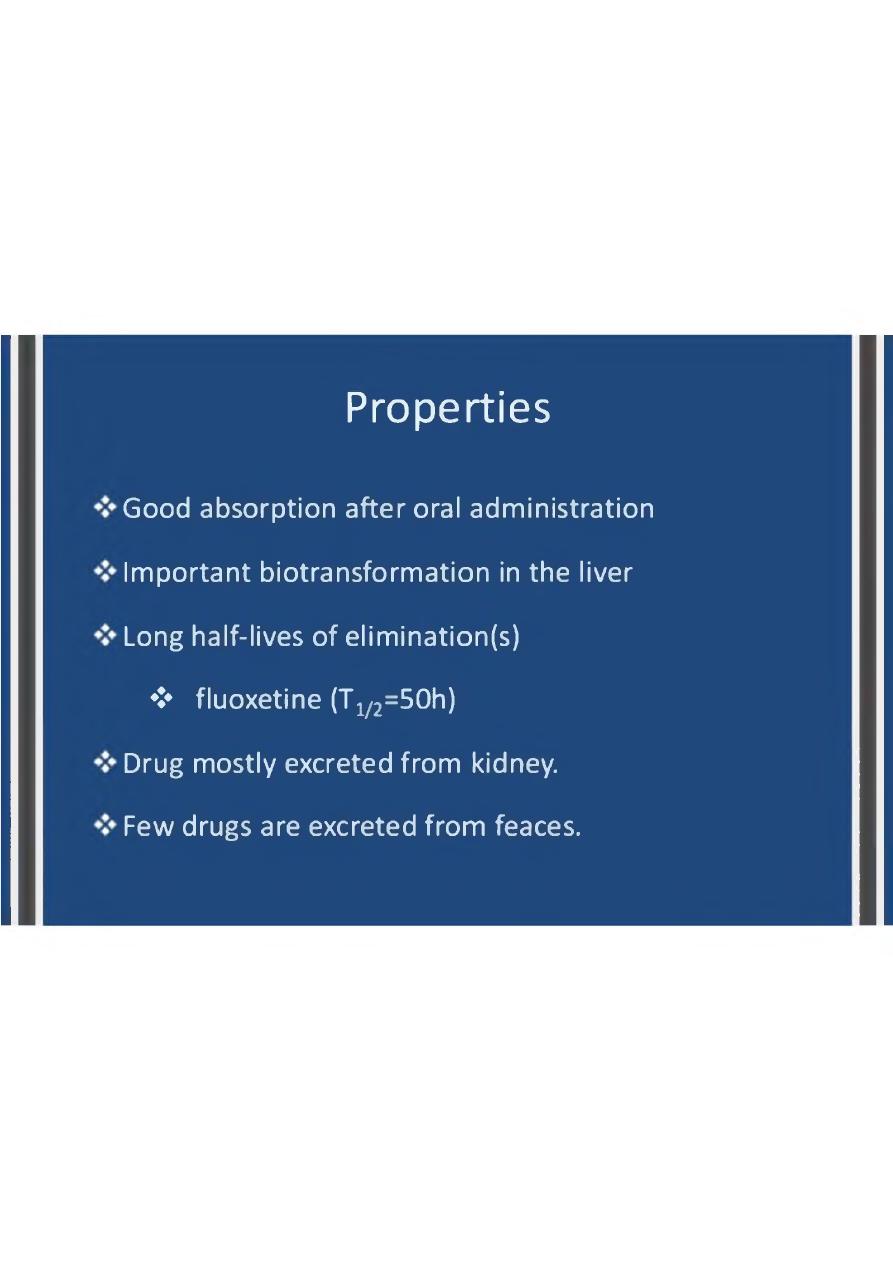
Properties
Good absorption after oral administration
Important biotransformation in the liver
Long half-lives of elimination(s)
❖ fluoxetine (T1/2=50h)
Drug mostly excreted from kidney.
Few drugs are excreted from feaces.
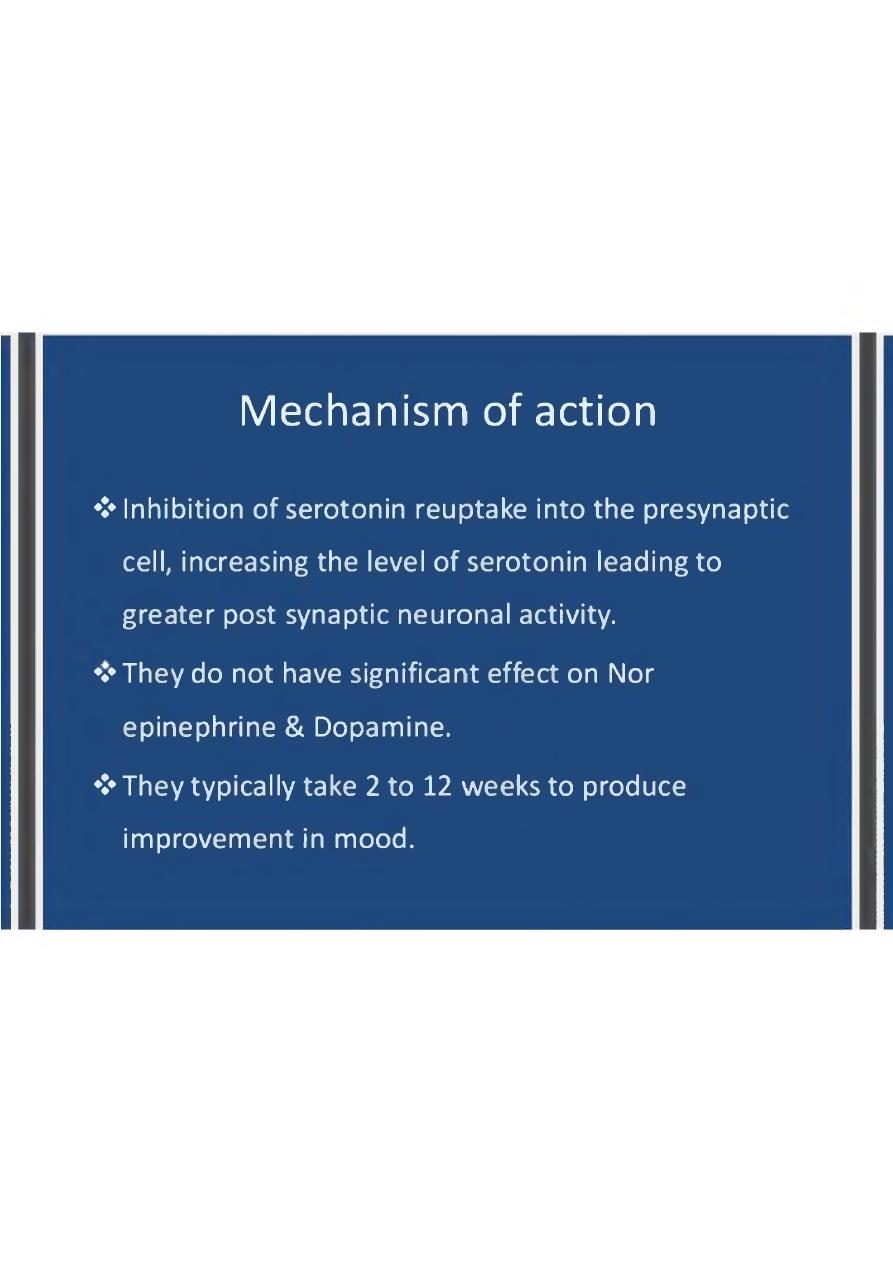
Mechanism of action
❖ Inhibition of serotonin reuptake into the presynaptic
cell, increasing the level of serotonin leading to
greater post synaptic neuronal activity.
♦ ♦ ♦ They do not have significant effect on Nor
epinephrine & Dopamine.
❖ They typically take 2 to 12 weeks to produce
improvement in mood.
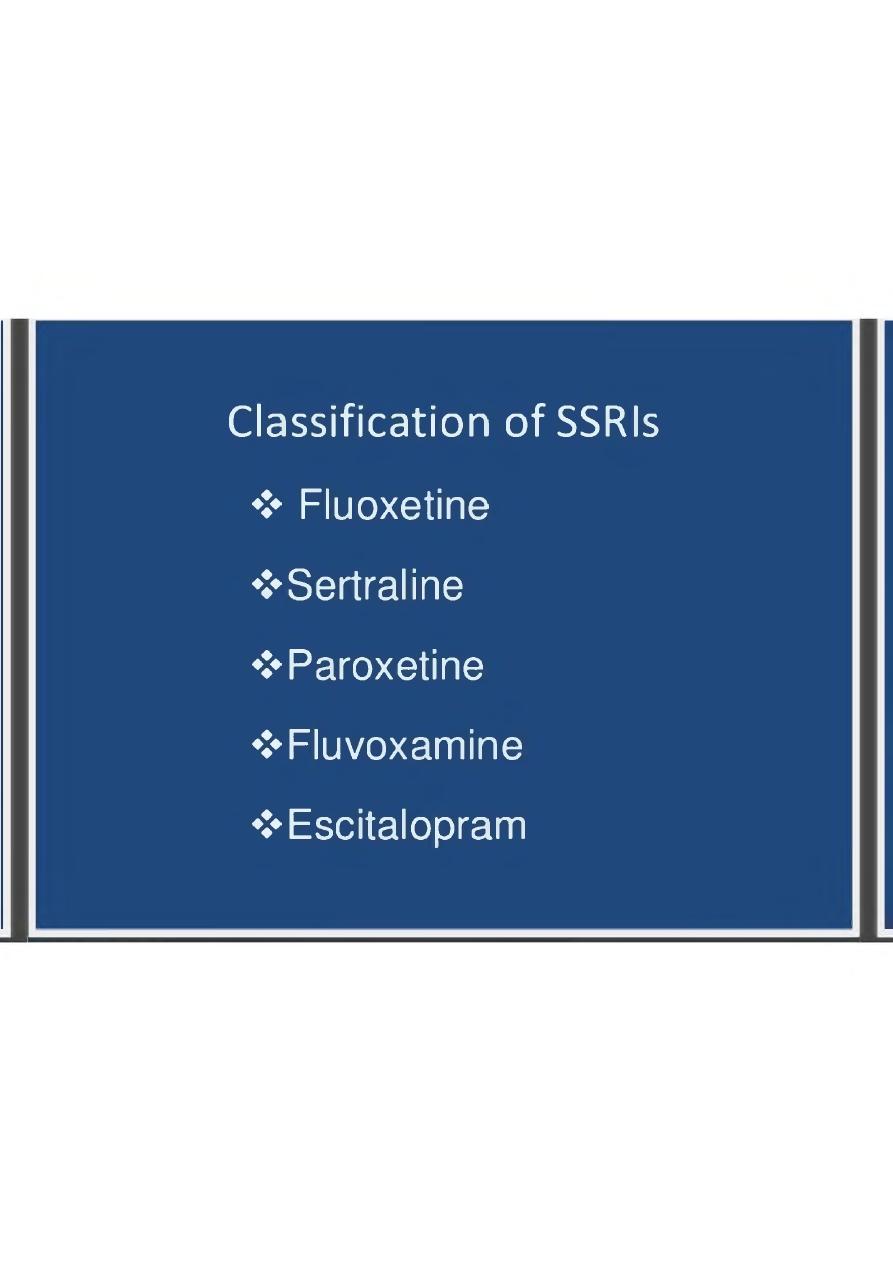
Classification of SSRIs
❖ Fluoxetine
❖ Sertraline
❖ Paroxetine
❖ Fluvoxamine
❖ Escitalopram
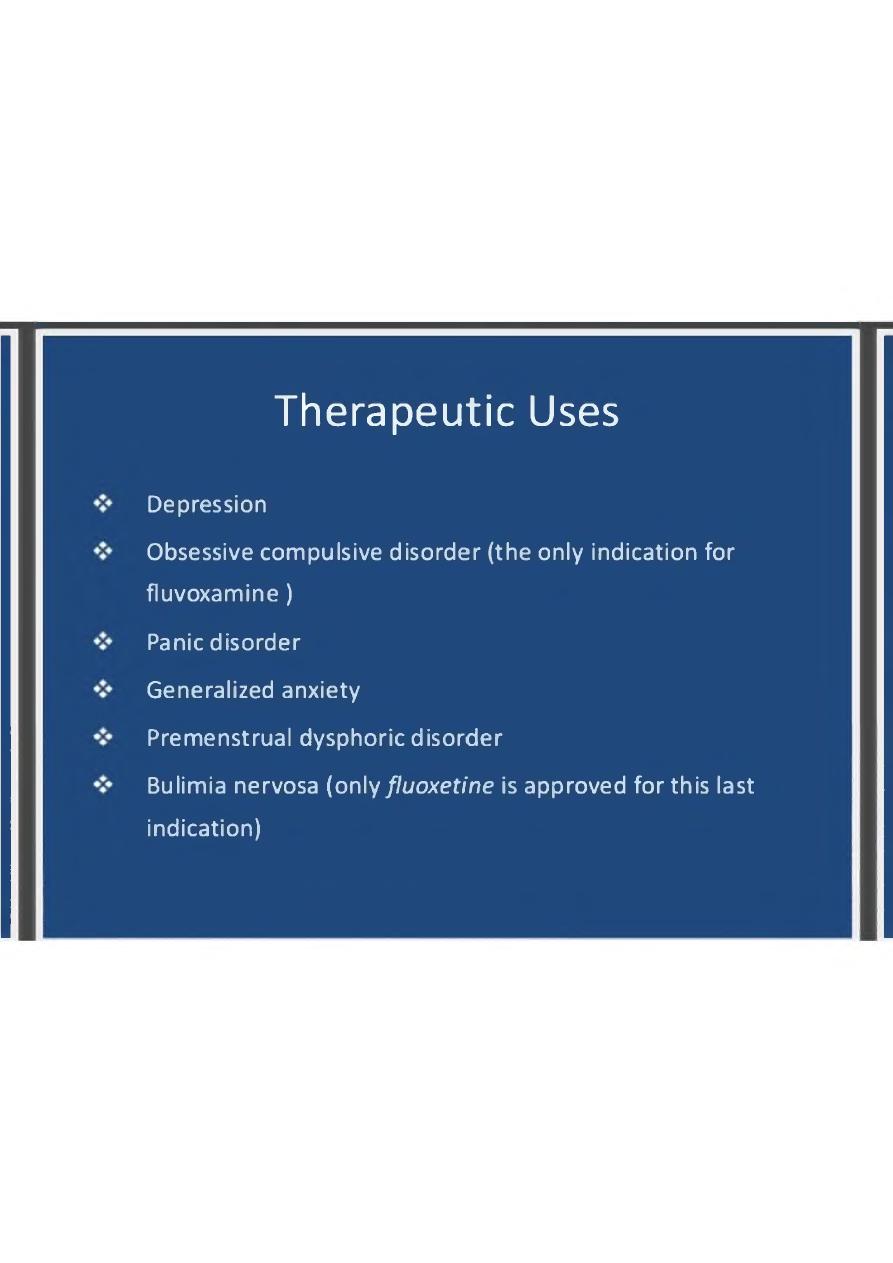
Therapeutic Uses
Depression
Obsessive compulsive disorder (the only indication for
fluvoxamine )
Panic disorder
Generalized anxiety
Premenstrual dysphoric disorder
Bulimia nervosa (only fluoxetine is approved for this last
indication)
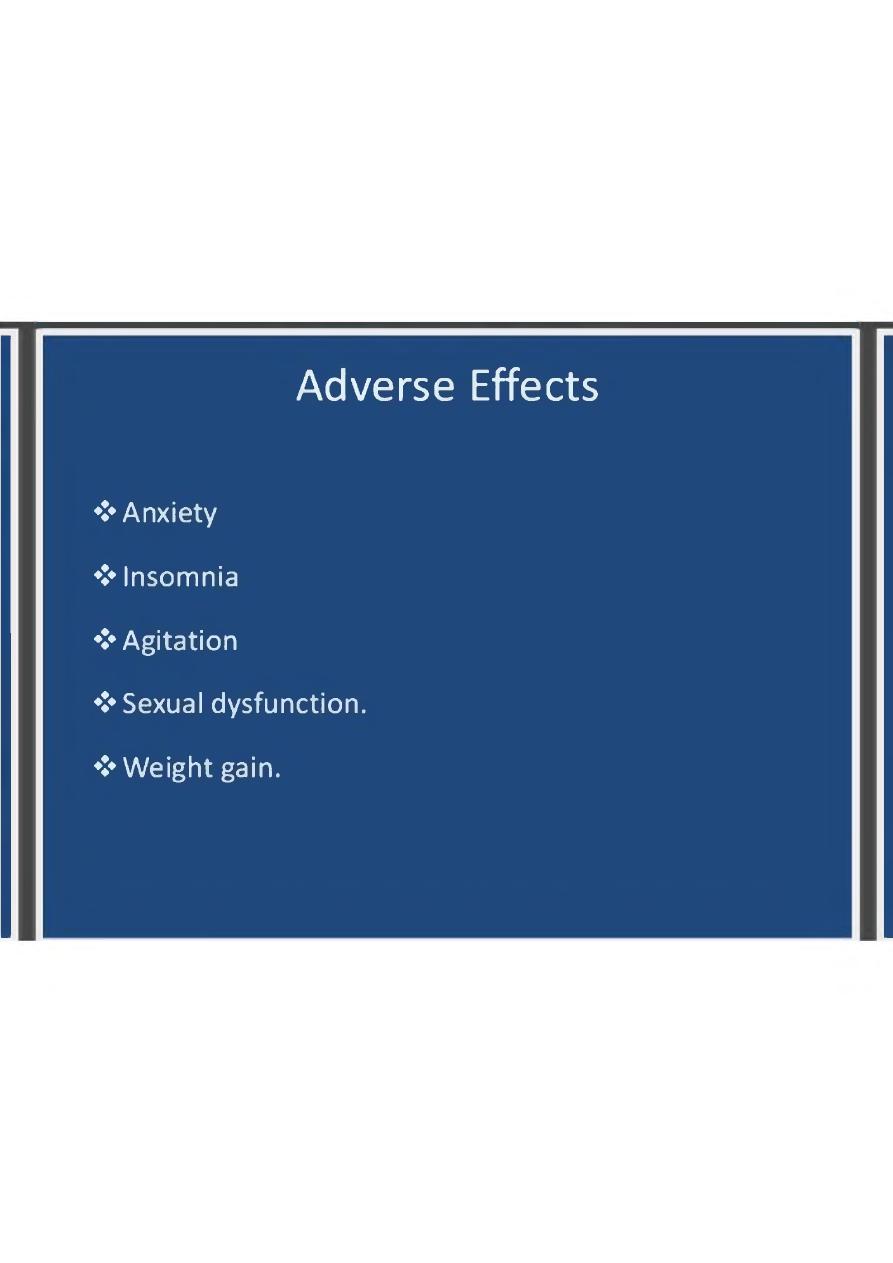
Adverse Effects
❖ Anxiety
❖ Insomnia
❖ Agitation
❖ Sexual dysfunction.
❖ Weight gain.
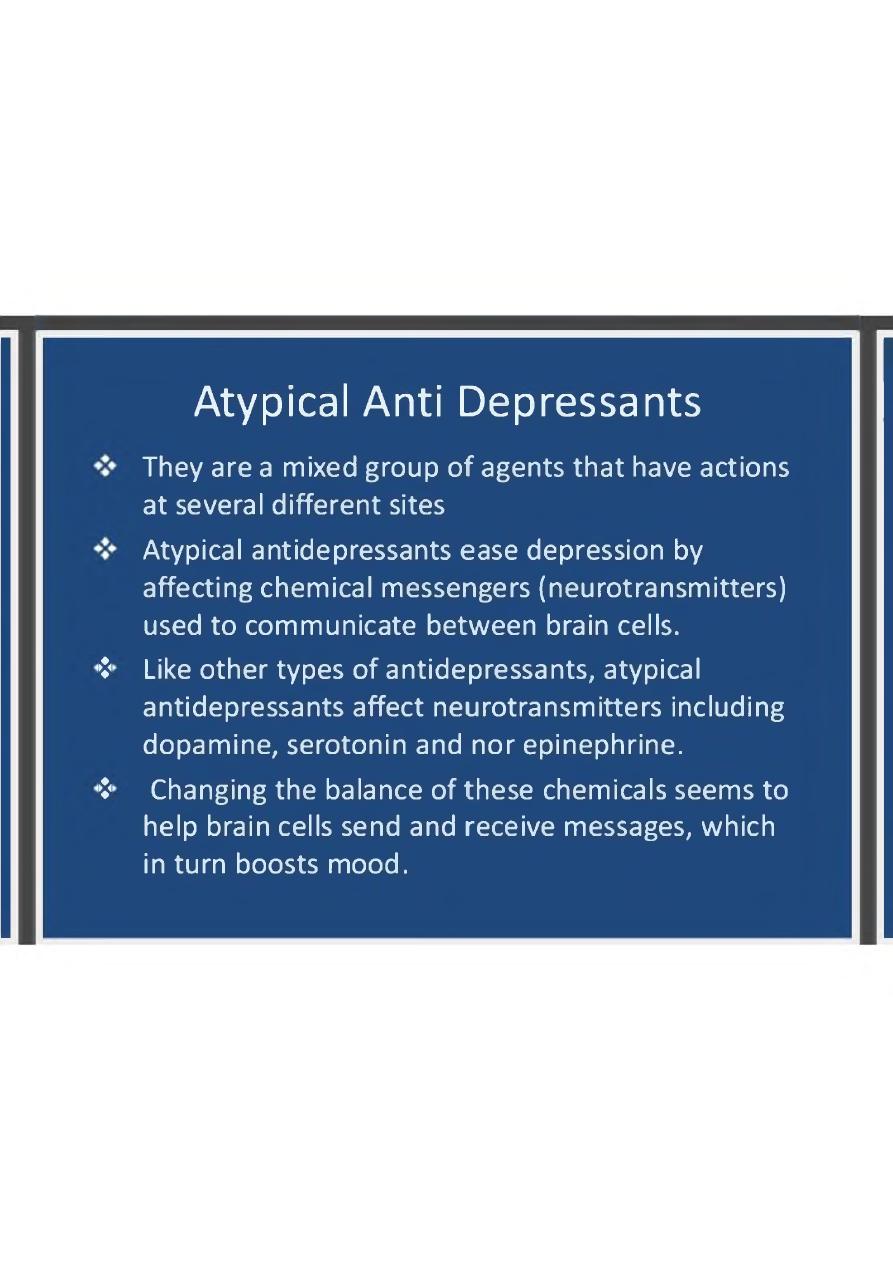
♦>
♦>
Atypical Anti Depressants
They are a mixed group of agents that have actions
at several different sites
Atypical antidepressants ease depression by
affecting chemical messengers (neurotransmitters)
used to communicate between brain cells.
Like other types of antidepressants, atypical
antidepressants affect neurotransmitters including
dopamine, serotonin and nor epinephrine.
Changing the balance of these chemicals seems to
help brain cells send and receive messages, which
in turn boosts mood.

Classification
❖ Bupropion
❖ Trazodone
❖ Mianserin
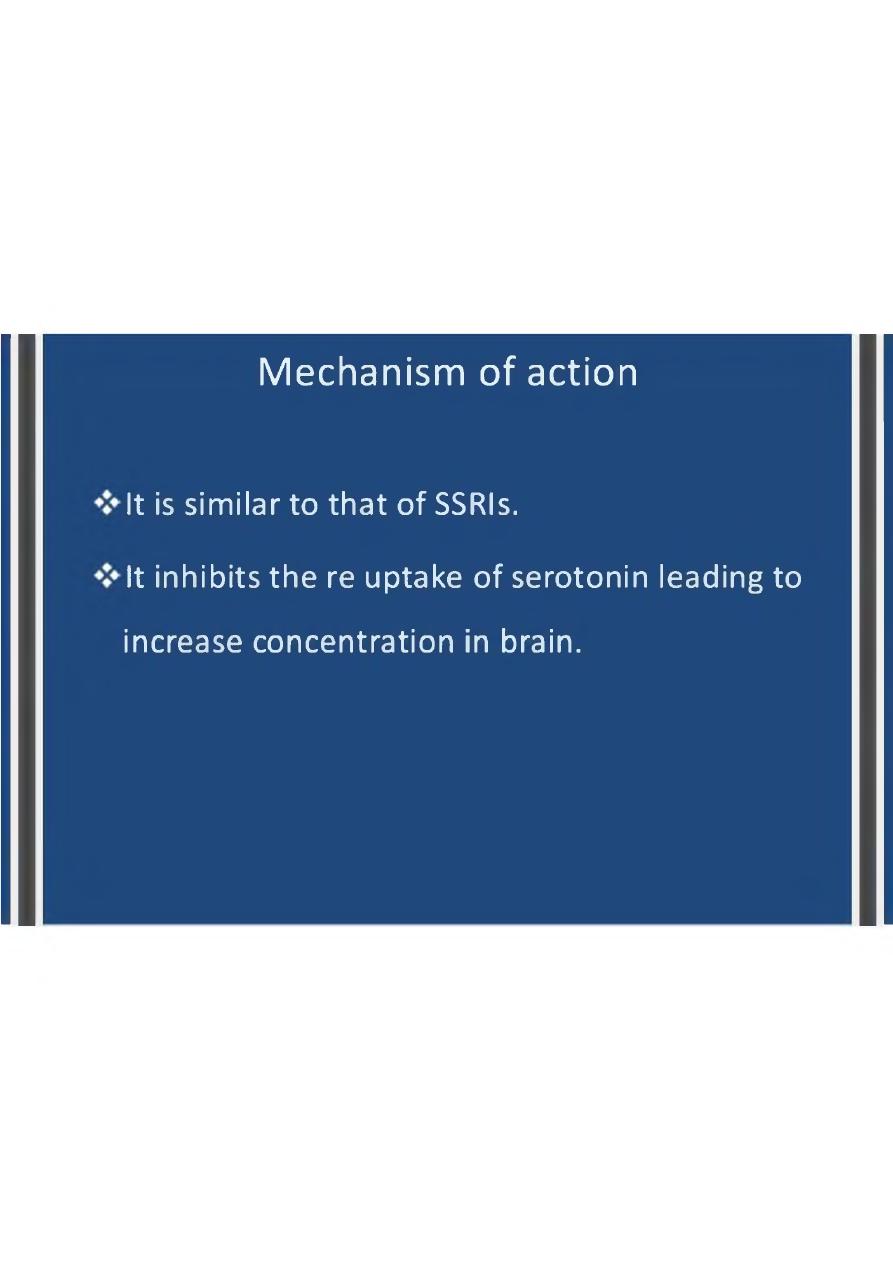
Mechanism of action
It is similar to that of SSRIs.
It inhibits the re uptake of serotonin leading to
increase concentration in brain.
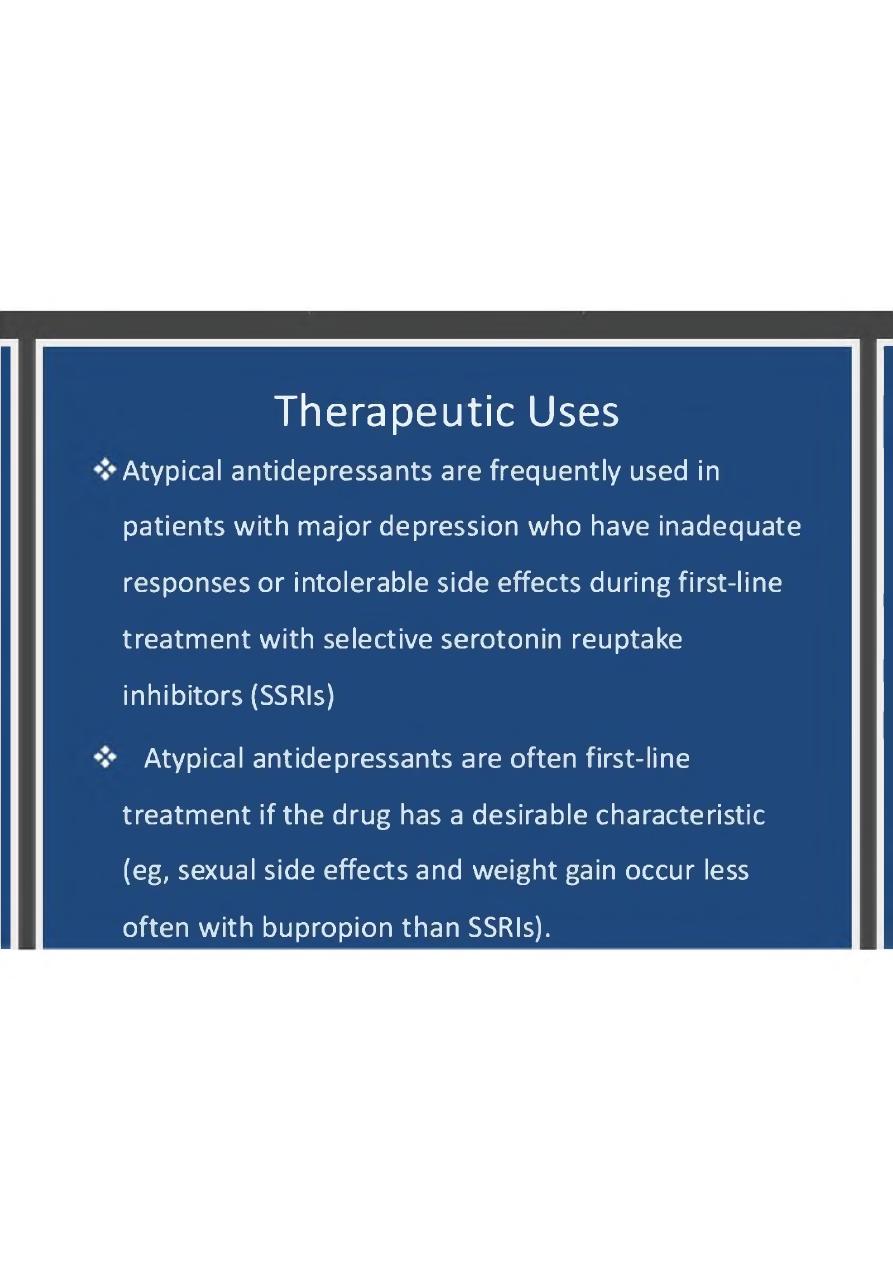
Therapeutic Uses
Atypical antidepressants are frequently used in
patients with major depression who have inadequate
responses or intolerable side effects during first-line
treatment with selective serotonin reuptake
inhibitors (SSRIs)
Atypical antidepressants are often first-line
treatment if the drug has a desirable characteristic
(eg, sexual side effects and weight gain occur less
often with bupropion than SSRIs).
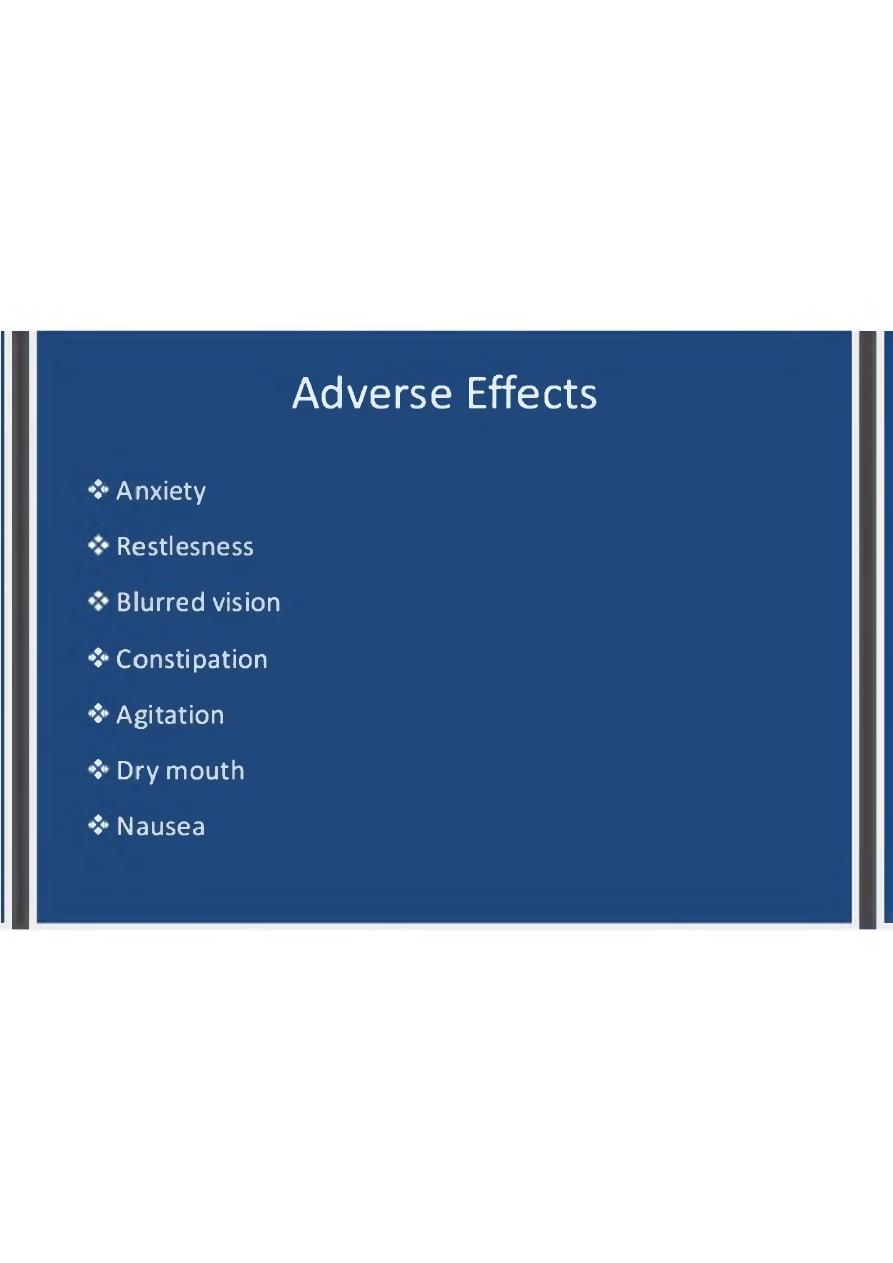
♦>
♦>
♦>
♦>
♦>
Adverse Effects
Anxiety
Restlesness
Blurred vision
Constipation
Agitation
Dry mouth
Nausea
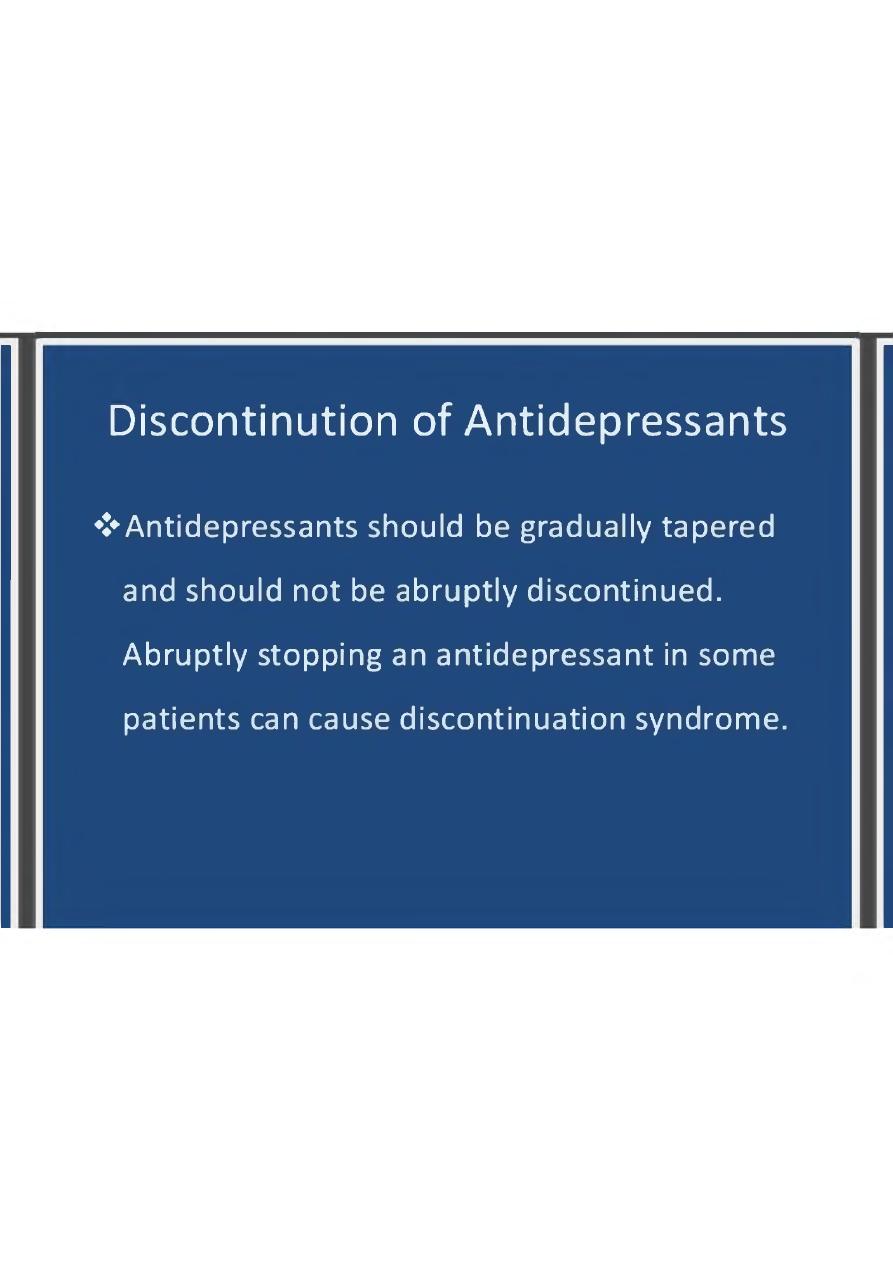
Discontinution of Antidepressants
❖ Antidepressants should be gradually tapered
and should not be abruptly discontinued.
Abruptly stopping an antidepressant in some
patients can cause discontinuation syndrome.
